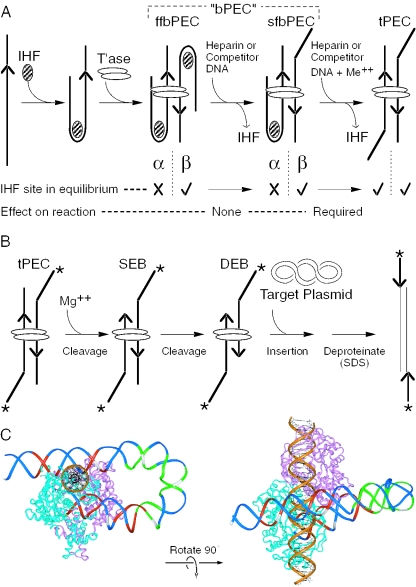Figure 1.
Assembly of the Tn10 transpososome and the chemical steps of the reaction. (A) Assembly and unfolding of the synaptic complex. Synapsis of two IHF-bound transposon arms by transposase produces an ffbPEC. Treatment with competitor DNA or heparin strips IHF from the β side of the complex to produce sfbPEC. IHF remains bound to the α side of the complex, presumably due to the subterminal transposase contacts with the transposon end. Divalent metal ion unlocks the IHF binding site on the α side of the complex. Dissociation of IHF produces the tPEC. Hatched oval, IHF; open ovals, transposase; and arrowhead, transposon end. In the tPEC, unoccupied IHF binding sites are indicated by a kink in the transposon end. (B) The chemical steps of the transposition reaction are illustrated using the tPEC as the starting point. In the presence of Mg++, the flanking DNA is cleaved to produce a SEB, followed by a DEB. Non-covalent interactions with a target site are followed by the strand transfer step that produces an insertion product. Asterisk, location of the 32P-label on the transposon end; other elements are as described in (A). (C) The Tn10 transpososome was modeled by superimposing the DNA from the IHF co-crystal structure onto the structure of the Tn5 transpososome (28,32,44,45). Superimposition of the IHF-folded DNA was achieved by minimizing the RMS difference in the position of the equivalent atoms in the Tn5 DNA. One transposon end, IHF and flanking DNA have been omitted for clarity. A section of B DNA (gold) has been docked in the target binding groove to illustrate its spatial relationship to the IHF-folded transposon arm. Regions of transposase and IHF mediated hydroxyl radical protection are shown in red and green, respectively. Every tenth nucleotide on the transferred strand is shown in white. The transposon end is seen embedded in the turquoise monomer of transposase. The subterminal transposase contacts are located on the top of the structure illustrated on the left.

